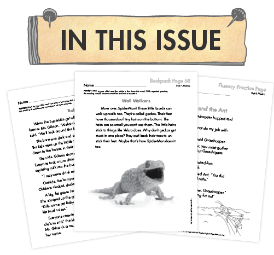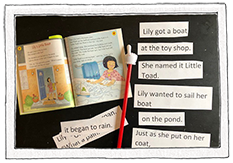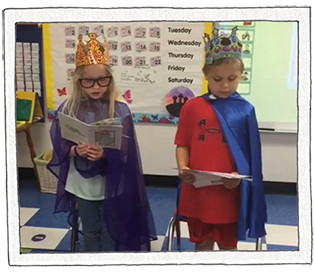|
|
|
|
ISSUE 16 | JAN. 2021
|
 
|
|
|
|
|
|
|
|
Welcome to the first Superkids Bulletin of
2021. In this issue, we will take a dive into the
topic of fluency. Fluency instruction and
practice are important because of their direct
link to reading comprehension. When
children develop fluency skills, they are better
able to understand the meaning of what they
read, which is the ultimate goal of reading.
During reading instruction, you may notice
children who read with little or
no expression and do not observe
punctuation. Others may have difficulty
saying sounds or words correctly; hesitate
when reading decodable words or Memory
Words; read word-by-word, slowly, and
haltingly; or struggle with phrases. You may
also observe these halting readers have
difficulty discussing what they have read.
These are all indicators that additional
fluency instruction and practice are needed.
When children read slowly and haltingly, it’s
hard for them to keep track of ideas
developed across sentences and paragraphs.
|
|
|
|
|
|

|
|
|
|
When you identify additional instruction is needed in any skill area, one of the biggest challenges
is determining where to start. Where is the ideal point of instruction? This is where intentional,
targeted assessment is important.
You can informally assess students’ fluency by listening as they read aloud in small groups. Is
the child reading words and observing punctuation accurately? Is the student reading smoothly?
Naturally? Keep in mind children in kindergarten and first grade are developing as readers, and
they will not always read fluently. But observation will reveal students’ progress over time and
indicate who needs help.
You may want to assess fluency more formally by keeping a record over time of the number of
words a child reads correctly per minute and record notes about reading accuracy. You may also
want to write down observations about phrasing, expression, and stress. Listen for the types of
errors a child makes and whether the child self-corrects. Look for patterns in errors, such as
misreading Memory Words or problems decoding a specific letter-sound correspondence. These
observation records can help you determine appropriate activities when you provide reteaching or
reinforcement as needed.
|
|

|
|
An excellent resource for determining
the point of instruction is the
Superkids Skill-Building Book. On the
back of the Fluency tab is a
collection of Quick Assessments.
These activities will help you assess
automaticity with words as well as
fluency in connected text.
The Workout Plan, on the front of the
Fluency tab, points you to skill-building activities that provide
targeted instruction and practice with
fluency skills. The Superkids Skill-Building Book has many fluency
building activities at the word level,
sentence level, and the passage level
to meet individual student needs.
|
|
|
|
|
Word Reading Fluency Practice
Fun Reading Practice
During the decoding Daily Routine or practice with
the Big Book of Decoding, have children begin
reading the words in a whisper and then get
louder with each word. Or, ask children to read the
words using a silly voice, such as a robot voice, a
squeaky mouse voice, or a loud monster voice.
One teacher shares she asks a different student
to pick the special voice each day before they
practice decoding. The child can “invent” a new
voice or select from a list of previously used
voices the teacher has recorded on chart paper.
|
|
|
|

|
|
Sing a Little Song
Try singing a list of decodable words or Memory Words to familiar tunes such as Happy Birthday
or Jingle Bells. One first-grade class sings Memory Words to the Batman theme song. For
example, “He, her, his, what, BATMAN! When, where, I, my, BATMAN! She, which, who, why,
BATMAN!” SUPER cute!
|
|
|
|
|
|
Flashlight Fun
Here’s another fun one. The teacher or the leader
of the day can begin by quickly flashing a light on
a word hanging on the classroom Sound Wall or
Memory Word Wall. Students are encouraged to
read the word before the light is turned off.
|
|
|
|
|
Word Races
Write the words you would like students to practice on strips of bulletin board paper or sentence strips. Pairs of students will “race” to read each word while pushing a car across the strip. The first car to the finish line is the winner.
|
|
|
|
|
|
|
Sentence and Passage Fluency
Chunk It!
If children struggle with reading whole passages, you can break the text into meaningful chunks or phrases. Printed fluency passages can be cut with scissors into smaller chunks. Or, you can select sentences or short phrases from Superkids text and write them on sentence strips or notecards for children to read.
|
|
|
|

|
|
Echo Reading
Echo reading is particularly helpful for practicing phrasing, reading rhythmically, and reading expressively. Read a sentence aloud from selected text and have children read the same sentence after you with the same expression and rate.
|
|
|
|
 Readers’ Theater
Readers’ Theater
For this activity, you will need to select a story and retype the text for each group. While in a small group, echo read the entire story together. Then, give each member just a chunk of the story. Echo read each part with each individual member while still in the small reading group. On their own, the group members will reread their part again and again until it is read easily. When the group is together again, ask the members to read their part as you listen. Repeat the individual practice and teacher-led practice until all members are comfortable reading their part orally. Finally, the group members will stand in order of the story parts and read their parts to the class in a Readers’ Theater format.
|
|
|
|
 Choral Reading
Choral Reading
Choral reading is a classic strategy for building fluency. First, read the text to a small group of students and discuss the meaning with them. It’s also important to point out aspects of fluency modeled during the reading. Next, the students read chorally with you. Finally, students choral read with a partner.
|
|
|
|
 Whisper Reading
Whisper Reading
After several exposures to the text during small-group time, children read the text simultaneously in a whisper voice. Unlike choral reading, they do not read in unison. As the children read, place a hand on a child’s shoulder. This is a signal to “turn the volume up.” Listen as the child reads a portion of the text. When the hand is removed, this is a signal to turn the reading volume back to a whisper. Move to the next child. This provides monitored independent reading practice and allows you to listen to one child read at a time.
|
|
|
|
 Partner Reading
Partner Reading
Partner reading is an effective, research-based strategy that most students really enjoy. One second-grade teacher shared she devotes a short block of time to partner reading every day. Students can sit anywhere they want in the classroom, but they only have one minute to get comfy. After that minute, she sets a timer for five minutes. Students take turns reading an assigned story from the Reader for the full five minutes. If they reach the end of the story before the time is up, they must go back to the beginning and read the story again.
|
|
|
|
|
|

|
 Back by popular demand is the printable Superkids calendar for 2021!
Back by popular demand is the printable Superkids calendar for 2021!
One Superkids teacher shared how she used her calendar last year. “I printed a calendar for each student. At the end of each school day, I ask my students to write one thing they learned and one thing that made them smile on the correct calendar date. It created a positive record of their days in second grade.” What a fun idea!
|
|
|
|
|
|

|
|
|
|
|